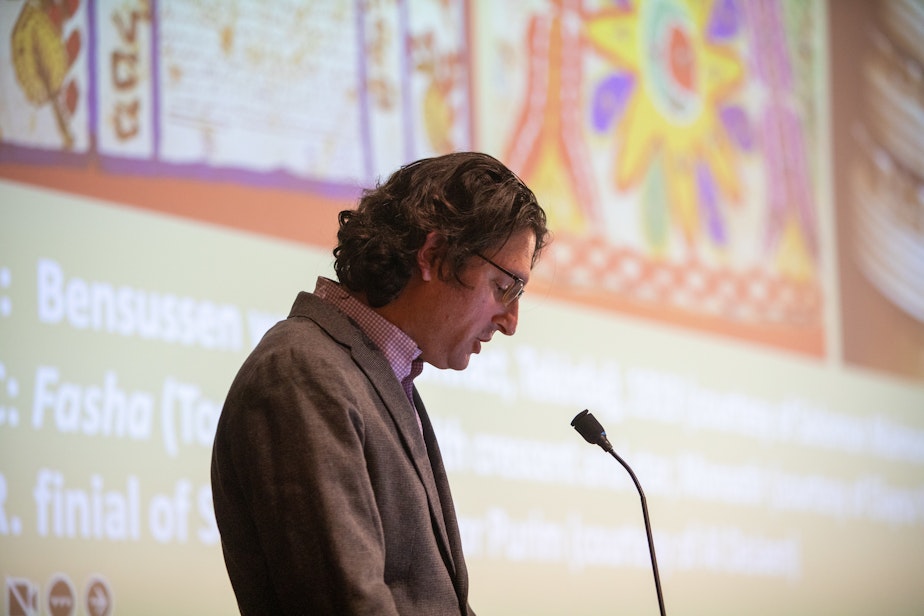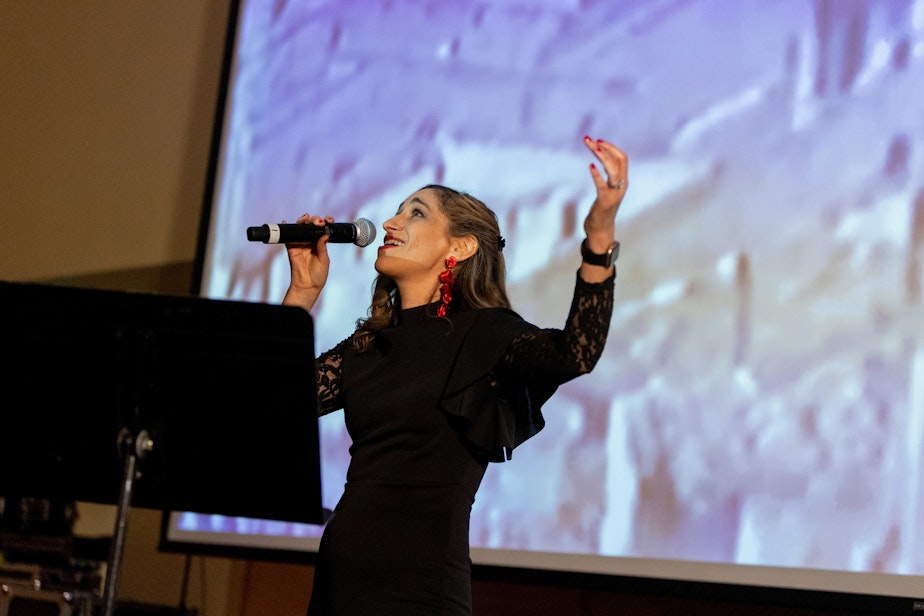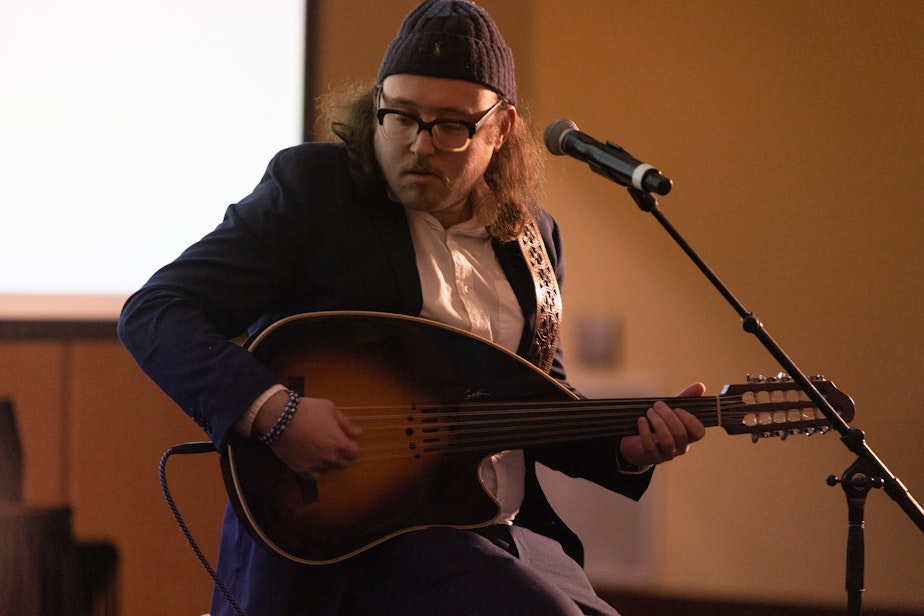'We are still here' – the art and culture of Seattle's Sephardic community

In a crowded room at the University of Washington, people walk from presentation to presentation.
There are poster boards up, displaying pictures of art, or explanations of an artist's medium and method. The smell of food drifts through the air from traditional cuisine that lines one wall of the room.
And the crowd is excited.
"I'm Sephardic. And this is my heritage," explains one person.
"There's nothing like this in Portland. I've never been at an event like this before," says another who drove up with her family for the occasion.
The event was called “Muestros Artistas," which means "Our Artists." It featured six Sephardic artists — a mix of musicians, writers, and painters from all over the U.S.

It was the University of Washington’s first Sephardic art symposium. It was likely the first anywhere in the U.S.
Sponsored
"I'm just thrilled whenever I hear the music or the literature, the stories, it's just so inspirational," explained Harvey Sadis, a local Seattleite who came to the event. "The Sephardic studies program here at the University of Washington is really on the map. Thanks in greater part to Devin Narr. And the fact that he's brought these artists together is just fantastic."
Devin Naar is the Isaac Alhadeff Professor in Sephardic Studies at the Stroum Center for Jewish Studies at the University of Washington. He’s spent the last 20 years in what he calls a salvaged linguistics operation.
"I went to college, and I began to be challenged, like, can you be Jewish, if your family is from Greece, or from the Muslim world, or what kind of name is Naar?" he explains. "And so that led me on a kind of a journey to speak to the elders in my family."
Naar is Sephardi. His family are Jewish people who come, originally, from Spain. But, in 1492, they were expelled by King Ferdinand and Queen Isabella. Many made their way across the Mediterranean to settle in what was then the Ottoman Empire.
Until the 20th century, Sephardic Jews continued living in the predominantly Muslim Ottoman Empire, developing their own culture, separate from the Eastern European, Ashkenazi Jewish culture that might come to mind when you think of, for example, "Fiddler on the Roof."
Sponsored
They also developed their own language, called Ladino.
"So it's based in Spanish, but it's got not only Hebrew, but Arabic and Greek and Turkish, Italian and French," Naar says.
He's spent the last 20 years learning Ladino, at first as an attempt to connect with his heritage. Later, he made it his career.
It’s also shaped how he’s raised his own family. Naar wanted his kids to learn the language, so when his first son was born, he spoke only Ladino to him for five years.
Seattle has the third largest Sephardic Jewish population in the U.S. And they make up more of the Jewish population here than anywhere else in the nation. Naar says there’s no one reason we know of why Sephardim moved to Seattle.
Sponsored
But there is a story:
"The folk narrative," says Naar, "is that a couple of guys from the eastern Mediterranean, what was then the Ottoman Empire, areas around what is now Rhodes, and an island near Istanbul, they had some Greek friends who told them essentially that there would be economic opportunities available for them if they came to United States."
But, they said, don't stop when you hit New York. Make your way to the West Coast, to Seattle.
"And I suppose they must come in the summertime because they reported back that it just like the Mediterranean over here in Seattle. And these couple of guys wound up bringing some relatives and sure enough, with in a few years, by the start of World War I, about a quarter of the Jews in Seattle were of Sephardic origin."
As generations pass, and Ladino fades from people’s vocabulary, it can be hard to feel connected to Sephardic traditions.
Sponsored
Naar sees it in his children. It’s been hard for them to want to speak Ladino, when no one else they know does.
So how do you go about building awareness of Sephardic culture and community in everyone else? One option is art.
Art, says Naar, can act as a new kind of glue for the community, to demonstrate to both Sephardim, and the broader world, that there is Sephardic art and culture, something that has often been erased.
Hence the symposium — "Muestros Artistas."

Sponsored
For the artists featured at the symposium, this is a chance to share their art, and their culture, with a crowd.
And, in Seattle, it’s a crowd that actually knows and understands Sephardic culture.
Singer songwriter and author Sarah Aroeste performs completely in Ladino, one of the few modern songwriters to do so.
She sang a piece she describes as semi-autobiographical.
"It's a song I wrote about the iconic Miranda, the dark-haired Sephardic girl who was kicked out of Spain and has been wandering the earth ever since," Aroeste says.
While she sings, there's a video playing behind her, black-and-white footage of her family in the Balkans in the 1930s.
"But as you watch the video, you slowly realize that everyone in the video would perish a few years later in the Holocaust," Aroeste explains. "But that I'm still here and that we are still here and the descendants are still here. And it is all the more so how important it is to be carrying on these traditions and to be sharing these stories not just for our own community, but for the wider community."

Asher Shasho Levy is a musician, as well as a hazzan, also known as a cantor. That’s the person who leads music at a temple or church.
Shasho Levy plays an instrument called an oud, which is similar to a lute. He’s been learning the oud since he was a kid. He says it acted as a connection to his family — both to his father, a musician and Rabbi, as well as to his grandparents, who fled from the Ottoman Empire during the Balkan Wars.
Shasho Levy says that connection to his Sephardic past felt especially important in an Ashkenazi-centered world.
"A lot of people in the Jewish world have no idea about these Sephardic communities and our traditions, or heritage, or music or, you know, unique approach to the spiritual elements of the faith as well, the approach to family, just everything," he explains. "I'm not an Ottoman Jewish man in my great grandparents' time, you know, that world doesn't exist. But it exists in the music, it exists in other elements of culture, and those become sort of vehicles for the identity."
Shasho Levy lives in San Francisco, but even in Seattle, with a larger Sephardic population, these traditions are the minority. There are two Sephardic temples here, but the rest are Ashkenazi. Jewish spaces, like restaurants, that do exist in Seattle typically serve Ashkenazi foods, like bagels and matzoh ball soup.
But even more than that, Naar says Seattle just doesn’t feel very Jewish.
"I think that it's sort of like the Jewishness is not necessarily a well-integrated feature of just the broader kind of Seattle culture," he explains.
That’s another reason why programs like "Muestros Artistas" are important. It brings Jewish culture, and particularly Sephardic culture, to the forefront.
"And I think the kind of reorientation, that exploration of Sephardic Jewish life and culture and arts can re-define how we think about who Jews are, what Jews do, and how they might fit or not, into the broader kind of American tapestry, and the Seattle fabric that we've had here," Naar says.
"Muestros Artistas" was the Sephardic Studies program’s first event since the pandemic. And it was special, for the artists, and the audience.
It was a chance to connect with other Sephardim, as well as with the larger Seattle community, through a medium that is often overlooked in Sephardic tradition.
And it won’t be the last event.
This Wednesday, Seattle’s Museum of History and Industry is holding a discussion with Dr. Devin Naar on Seattle’s Sephardic Jewish community in the 20th century. You can find more information about the event at this link.





